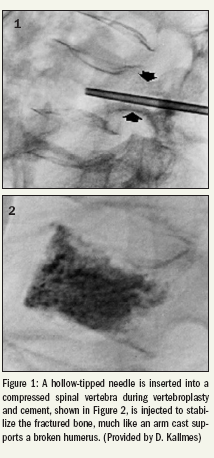Vertebroplasty proves no better at easing pain than placebo
Interventional radiologists are coming to grips with the implications of two groundbreaking clinical trials indicating that vertebroplasty relieves pain from osteoporotic vertebral fractures no better than a sham version of the procedure.
Interventional radiologists are coming to grips with the implications of two groundbreaking clinical trials indicating that vertebroplasty relieves pain from osteoporotic vertebral fractures no better than a sham version of the procedure.
Results from Mayo Clinic in Rochester, Minnosta, and Cabrini Medical Center in Malvern, Australia, were published simultaneously Aug. 5 in the New England Journal of Medicine.
Unlike past trials that examined only treated patients, the Mayo and Cabrini studies compared results from patients who underwent vertebroplasty with patients who were randomly selected to receive sham interventions.
The study findings suggest that the clinical benefit of vertebroplasty may stem from a placebo effect rather than the therapeutic impact of cement injected to stabilize fractured vertebral segments.

In the Mayo trial, 131 patients with painful osteoporotic spinal fractures received either vertebroplasty with a standard administration of polymethylmethacrylate cement or a sham procedure without cement injection. Dr. David F. Kallmes, a professor of radiology, and colleagues at Mayo Clinic and 10 collaborating facilities in the U.S., U.K., and Australia found that both groups experienced an immediate improvement in disability and pain following intervention. No significant differences were observed between the two groups at one and three months after the procedures.
First author Rachelle Buchbinder, Ph.D., and colleagues in Australia found that 38 patients who underwent vertebroplasty for osteoporotic fractures experienced about the same level of pain relief and quality-of-life improvement as 40 patients who received a sham procedure.
The results explain why vertebroplasty is effective, a question that previous trials did not answer, Kallmes said in an interview. The new studies led researchers to reject the assumption that injected cement is the source of pain relief. A lidocaine anesthetic drug used for both sets of patients in both studies may confer a benefit, but placebo effect is the most plausible reason why patients felt less pain after the procedures, he said.
Interventional radiologists initially challenged these findings, mainly on methodological grounds. Dr. J. Kevin McGraw, section head of vascular and interventional radiology at Riverside Methodist Hospital in Columbia, Ohio, expressed concern that the Australian study was susceptible to patient selection bias because more than 30% of patients who met its inclusion criteria decided not to participate.
McGraw was involved with the early stage of the Mayo study as well. He recalled that many patients refused to volunteer because they feared being selected for a sham procedure that would deny them pain treatment. Such experience explains why Mayo and Australian researchers needed five and four years, respectively, to recruit volunteers for their trials. Both efforts ultimately involved small numbers of patients, he said.
“We need larger studies and larger patient numbers,” he said.
Dr. Allan L. Brook, director of interventional neuroradiology at Montefiore Medical Center in New York, repeated McGraw’s concerns about patient selection and trial population size.In his view, the level of pain experienced by patients in the two studies was also substantially less severe than pain levels described by his patients before treatment.
The two small-scale trials should not be considered statistically powerful enough to set a new standard for vertebroplasty’s efficacy, he said.
“It is hard to believe 78 patients in one study and 131 in another can match the positive experience of 100,000 patients and millions worldwide who are successfully treated with vertebroplasty augmentation,’ he said.
However, Kallmes said the new findings do not contradict previously published trials. The pain relief experiences of patients who received vertebroplasty in the Mayo and Australian studies are similar to findings from many cohort studies in the medical literature.
“Everybody is right,” he said. “It is not that people are not getting better with vertebroplasty-they are,” he said. “The problem is that we saw the same benefit in the placebo group.”
GE HealthCare Debuts AI-Powered Cardiac CT Device at ACC Conference
April 1st 2025Featuring enhanced low-dose image quality with motion-free images, the Revolution Vibe CT system reportedly facilitates improved diagnostic clarity for patients with conditions ranging from in-stent restenosis to atrial fibrillation.
The Reading Room Podcast: Current Perspectives on the Updated Appropriate Use Criteria for Brain PET
March 18th 2025In a new podcast, Satoshi Minoshima, M.D., Ph.D., and James Williams, Ph.D., share their insights on the recently updated appropriate use criteria for amyloid PET and tau PET in patients with mild cognitive impairment.